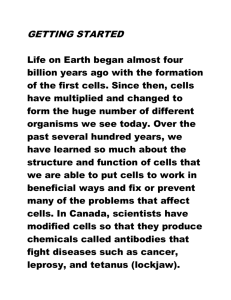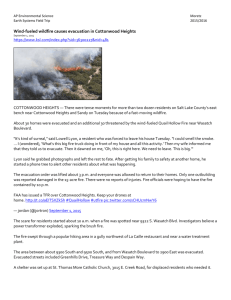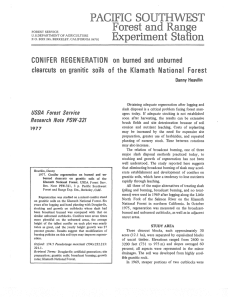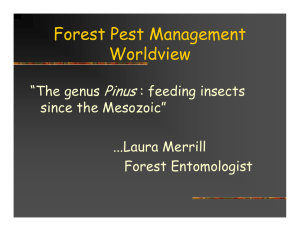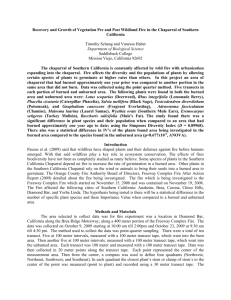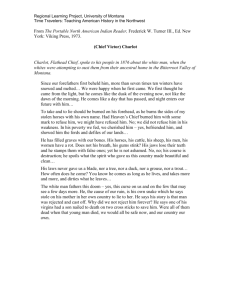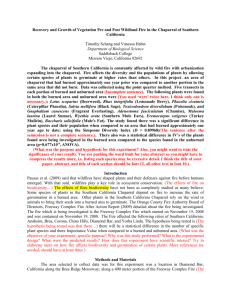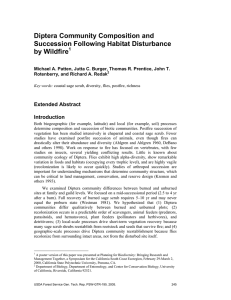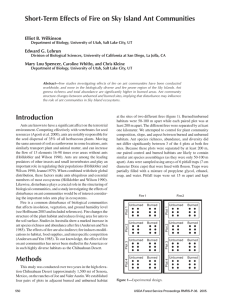Burned vs Unburned - Sagehen Creek Field Station
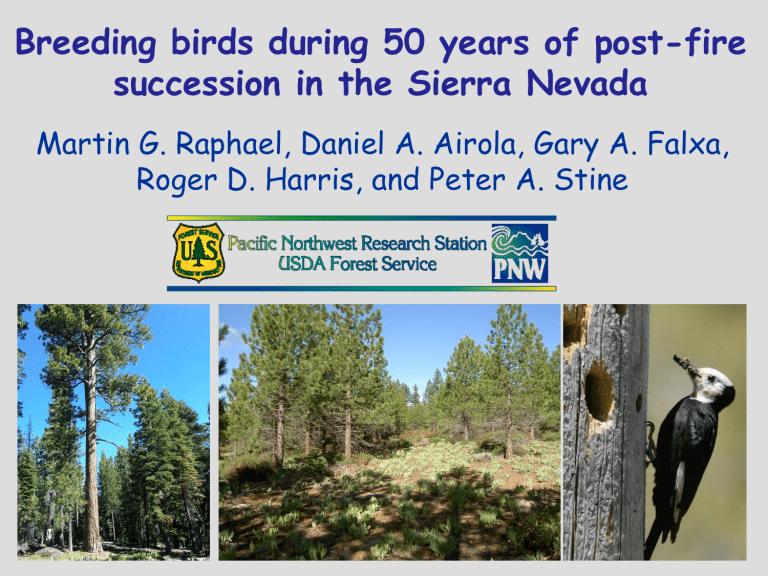
Breeding birds during 50 years of post-fire succession in the Sierra Nevada
Martin G. Raphael, Daniel A. Airola, Gary A. Falxa,
Roger D. Harris, and Peter A. Stine
1960 - The Donner Fire burned ~18,000 ha on the eastern Sierra Nevada
1965 – two 8.5-ha permanent plots established
Burned Plot
Unburned Plot
Objectives
Examine and contrast changes in vegetation over ~50-yr time series
Estimate bird abundance and diversity and compare results on burned and unburned plots over 50-yr
Relate changes in bird community to changes in vegetation
Monitoring timeline
1960 1970 1980 1990 2000 2010
Burned plot has changed dramatically over time
(no management or harvest)
1965 2012
Field equipment (and people) have changed too
1965 2012
20
15
10
5
0
35
30
25
1968
Density of Snags
(number > 38 cm/ha)
1975 1983 2012
Burned
Unburned
Percent Cover, Shrubs
( n = 1170 points)
80
70
60
50
40
30
20
10
0
1975 1983 2011
Burned
Unburned
40
30
20
10
0
70
60
50
Herbs & Grasses
(% cover, n = 1170 points)
1975 1983 2011
Burned
Unburned
60
50
40
30
20
10
0
Basal Area of Conifers
(m 2 /ha)
Burned
60
Unburned
1975 1983 2011
50
40
30
20
10
0
1975 1983 2011
Other
White fir
Yellow pine
90
80
70
60
50
40
30
20
10
0
Conifer Canopy Cover
(%, n = 1170)
Burned Unburned
1975
2011
50
40
30
20
10
0
1960
Total Bird Territories
1980
Unburned
Burned
2000 2020
30
25
20
15
10
5
0
1960
Species Richness
1980
Unburned
Burned
2000 2020
Foraging guilds
Wood excavating (woodpeckers)
Bark gleaning (nuthatches, brown creeper)
Flycatching (nighthawk, flycatchers)
Canopy foliage searching (jays, chickadees, kinglets, vireos, warblers)
Ground/brush searching (quail, dove, hummingbirds, bluebird, solitaire, thrush, robin, towhee, juncos, finches, sparrows)
Wood Excavating
Bark gleaning
Flycatching
Canopy Foliage Searching
Ground/brush Searching
Percent Similarity
(Ruzicka’s Index)
60
50
40
30
20
10
0
Burned vs Unburned
60
50
40
30
20
10
0
1966-68 vs 2010-14
Burned Unburned
Increased
Species
Hermit warbler
Pileated woodpecker
Common raven
Osprey
Northern goshawk
Clark’s nutcracker
Blackthroated gray warbler
Green-tailed towhee
Major Changes in Species Abundance
1960s
Absent
Absent
2010s
Common
Rare
Decreased
Species
Mountain bluebird
Brewer’s sparrow
Cooper’s hawk
1960s
Common
Sooty grouse Moderate
House wren
Pygmy nuthatch
American kestrel
Lazuli bunting
Lewis’ woodpecker
Rare
2010s
Absent
Absent
Absent
Temperature has increased over time
Summary
Vegetation is still changing, 50 years after fire on the burned plot, but also on the unburned plot
Bird community structure (guilds and species represented) has changed dramatically on the burned plot in response to vegetation change
The bird community on the unburned plot has also changed, to a smaller degree
Overall species richness has been comparable on plots over time
Bird abundance (# territories) has increased by roughly 50% on both plots
Some bird population changes could be due to climate change
Thanks to
Sagehen Creek Field Station for accommodation and logistics
Station managers Jeff Brown and Faerthen
Felix for help and advice
Carl and Jane Bock for initiating this work and suggesting our recent follow-up surveys
Meryl Sundove and Joe Batres for field assistance
Truckee Ranger District for protecting plots
Pacific Northwest and Pacific Southwest
Research Stations for funding
